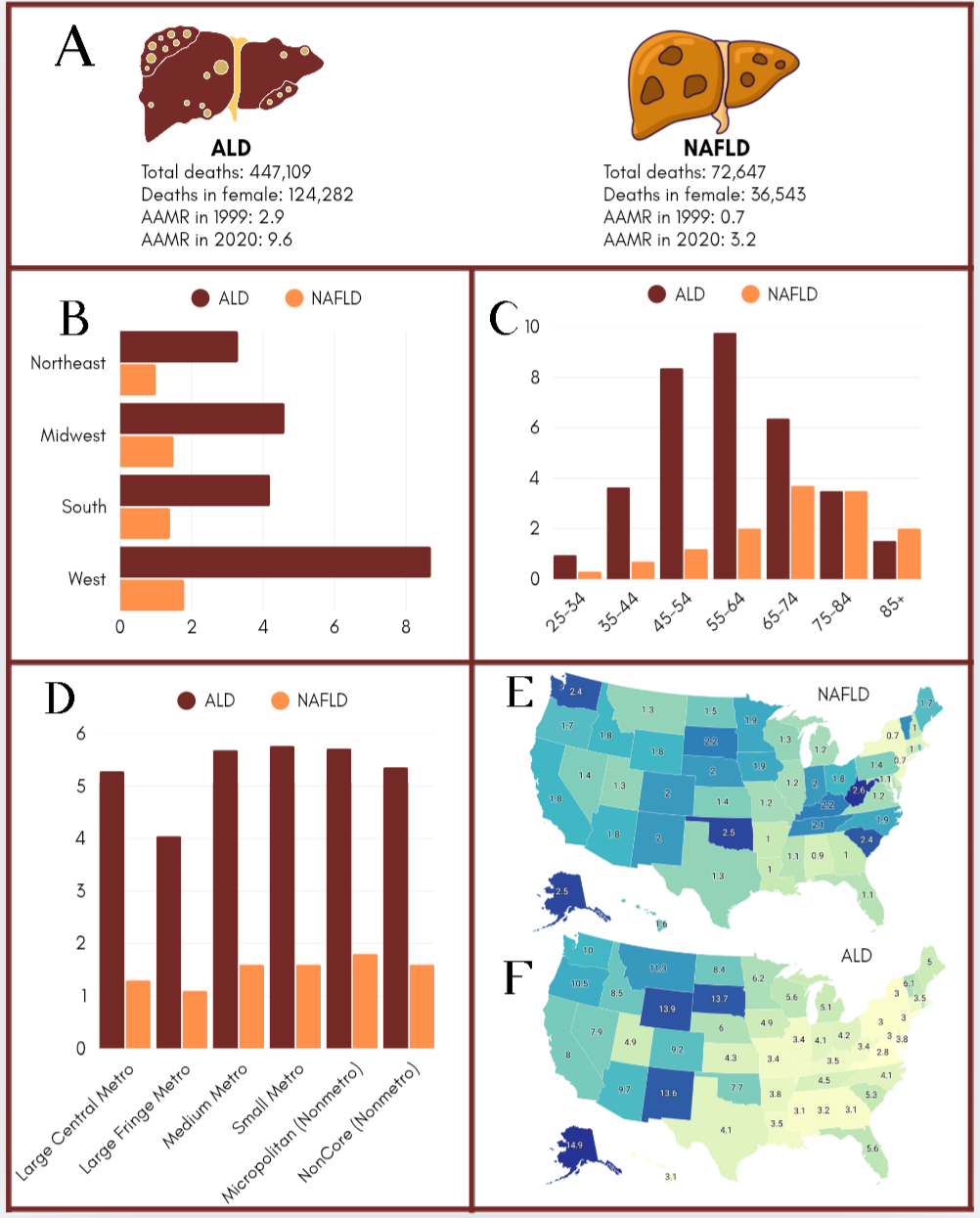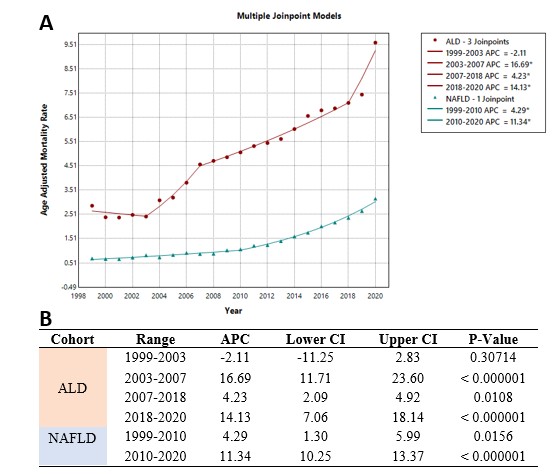Sunday Poster Session
Category: Liver
P1494 - Demographic Disparities in Liver Disease Mortality Trends in US Women: A Nationwide Retrospective Analysis of ALD and NAFLD
Sunday, October 26, 2025
3:30 PM - 7:00 PM PDT
Location: Exhibit Hall
- MF
Muhammad Imtanan Fazal, MD (he/him/his)
Jewish Hospital of Cincinnati
Cincinnati, Ohio
Presenting Author(s)
Fatima Zafar, MBBS1, Hamna Manan, MBBS2, Muhammad Romail Manan, MBBS, BSc1, Iqra Nawaz, MBBS, BSc3, Muhammad Imtanan Fazal, MD4, Omer Usman, MD5, Ahmad Zain, MBBS6, Syed Muhammad Ali Najafi, MBBS7, Malik Ahsan Safdar, MBBS1
1Services Institute of Medical Sciences, Lahore, Punjab, Pakistan; 2University Hospital Southampton NHS Foundation Trust, Southampton, England, United Kingdom; 3Bahawal Victoria Hospital, Bahawalpur, Bahawalpur, Punjab, Pakistan; 4Jewish Hospital of Cincinnati, Cincinnati, OH; 5Texas Tech University Health Sciences Center, El Paso, TX; 6Parkview Medical Center, Pueblo, CO; 7Services Institute of Medical Sciences, New Haven, CT
Introduction: Alcoholic liver disease (ALD) and non-alcoholic fatty liver disease (NAFLD), both marked by hepatic steatosis, are among the major causes of morbidity and mortality in the United States (US). Emerging evidence highlights disparities in liver disease mortality among women, particularly under racial, socioeconomic, and geographic parameters. While ALD is associated with increased use of alcohol, NAFLD has the highest increasing trend in prevalence in the US over the last 20 years given the underlying epidemic of obesity.
Methods: We conducted a retrospective analysis using mortality data from CDC WONDER database for women aged ≥ 25 years, with ALD or NAFLD from 1999 to 2020. Temporal trends in age-adjusted mortality rates (AAMR) per 100,000 population were noted, and stratified in terms of race, urbanization, state and census region. Mortality data in different age-groups was given as crude mortality rate (CMR) per 100,000. Joinpoint was used to determine the annual percentage change (APC).
Results: Between 1999 and 2020, ALD caused 447,109 deaths in the US, including 124,282 women, while NAFLD accounted for 72,647 deaths, of which 36,104 were women. ALD-related AAMR in women initially declined (1999-2003; APC -2.1), followed by a significant rise; 2003-2007 (APC 16.7), 2007-2018 (APC 4.2), and 2018-2020 (APC 14.1). During this twenty-year period, NAFLD-related mortality also increased significantly; 1999-2010 (APC 4.3), and 2010-2020 (APC 11.3).
Highest mortality among women with ALD was noted in patients aged 55-64 years with a CMR of 9.8, while NAFLD-related CMR was highest among the 65-74 years age bracket (3.7).
Urbanization analysis showed highest ALD-related AAMR among women in small metro areas (5.8), and the highest NAFLD AAMR was observed in micropolitan areas (1.8). Regional analysis showed highest AAMR in the West in both – ALD (8.7) and NAFLD (1.8). Alaska had the highest ALD-related AAMR (14.9), while NAFLD-related AAMR was highest in West Virginia (2.6).
In terms of race, American Indian/Alaska Native population had the highest AAMR among both ALD (35.1) and NAFLD (4.3).
Discussion: A rising trend in mortality, accompanied by clear disparities, has been observed for both ALD and NAFLD in women. Particularly concerning is the higher mortality rate among American Indian women. This highlights the need to study reasons behind the noted disparities to emphasize tailored public health strategies to address the interplay of social, environment, and genetic determinants of health.

Figure: A. Line graph representing temporal trends in AAMR for ALD and NAFLD modelled with Joinpoint regression to identify statistically significant shifts. B. Table showing annual percentage change (APC) for each temporal segment along with 95% confidence intervals and corresponding p-values.

Figure: A. Total deaths and age-adjusted mortality rates (AAMR) associated with alcoholic liver disease (ALD) and non-alcoholic fatty liver disease (NAFLD) in 1999 and 2020. B. Regional variation in AAMR by U.S. Census regions. C. Crude mortality rate across different age groups. D. AAMR stratified by urbanization status (rural vs urban). E. Choropleth map representing state-wise NAFLD-associated AAMR across the U.S. F. Choropleth map representing state-wise ALD-associated AAMR the U.S.
Disclosures:
Fatima Zafar indicated no relevant financial relationships.
Hamna Manan indicated no relevant financial relationships.
Muhammad Romail Manan indicated no relevant financial relationships.
Iqra Nawaz indicated no relevant financial relationships.
Muhammad Imtanan Fazal indicated no relevant financial relationships.
Omer Usman indicated no relevant financial relationships.
Ahmad Zain indicated no relevant financial relationships.
Syed Muhammad Ali Najafi indicated no relevant financial relationships.
Malik Ahsan Safdar indicated no relevant financial relationships.
Fatima Zafar, MBBS1, Hamna Manan, MBBS2, Muhammad Romail Manan, MBBS, BSc1, Iqra Nawaz, MBBS, BSc3, Muhammad Imtanan Fazal, MD4, Omer Usman, MD5, Ahmad Zain, MBBS6, Syed Muhammad Ali Najafi, MBBS7, Malik Ahsan Safdar, MBBS1. P1494 - Demographic Disparities in Liver Disease Mortality Trends in US Women: A Nationwide Retrospective Analysis of ALD and NAFLD, ACG 2025 Annual Scientific Meeting Abstracts. Phoenix, AZ: American College of Gastroenterology.
1Services Institute of Medical Sciences, Lahore, Punjab, Pakistan; 2University Hospital Southampton NHS Foundation Trust, Southampton, England, United Kingdom; 3Bahawal Victoria Hospital, Bahawalpur, Bahawalpur, Punjab, Pakistan; 4Jewish Hospital of Cincinnati, Cincinnati, OH; 5Texas Tech University Health Sciences Center, El Paso, TX; 6Parkview Medical Center, Pueblo, CO; 7Services Institute of Medical Sciences, New Haven, CT
Introduction: Alcoholic liver disease (ALD) and non-alcoholic fatty liver disease (NAFLD), both marked by hepatic steatosis, are among the major causes of morbidity and mortality in the United States (US). Emerging evidence highlights disparities in liver disease mortality among women, particularly under racial, socioeconomic, and geographic parameters. While ALD is associated with increased use of alcohol, NAFLD has the highest increasing trend in prevalence in the US over the last 20 years given the underlying epidemic of obesity.
Methods: We conducted a retrospective analysis using mortality data from CDC WONDER database for women aged ≥ 25 years, with ALD or NAFLD from 1999 to 2020. Temporal trends in age-adjusted mortality rates (AAMR) per 100,000 population were noted, and stratified in terms of race, urbanization, state and census region. Mortality data in different age-groups was given as crude mortality rate (CMR) per 100,000. Joinpoint was used to determine the annual percentage change (APC).
Results: Between 1999 and 2020, ALD caused 447,109 deaths in the US, including 124,282 women, while NAFLD accounted for 72,647 deaths, of which 36,104 were women. ALD-related AAMR in women initially declined (1999-2003; APC -2.1), followed by a significant rise; 2003-2007 (APC 16.7), 2007-2018 (APC 4.2), and 2018-2020 (APC 14.1). During this twenty-year period, NAFLD-related mortality also increased significantly; 1999-2010 (APC 4.3), and 2010-2020 (APC 11.3).
Highest mortality among women with ALD was noted in patients aged 55-64 years with a CMR of 9.8, while NAFLD-related CMR was highest among the 65-74 years age bracket (3.7).
Urbanization analysis showed highest ALD-related AAMR among women in small metro areas (5.8), and the highest NAFLD AAMR was observed in micropolitan areas (1.8). Regional analysis showed highest AAMR in the West in both – ALD (8.7) and NAFLD (1.8). Alaska had the highest ALD-related AAMR (14.9), while NAFLD-related AAMR was highest in West Virginia (2.6).
In terms of race, American Indian/Alaska Native population had the highest AAMR among both ALD (35.1) and NAFLD (4.3).
Discussion: A rising trend in mortality, accompanied by clear disparities, has been observed for both ALD and NAFLD in women. Particularly concerning is the higher mortality rate among American Indian women. This highlights the need to study reasons behind the noted disparities to emphasize tailored public health strategies to address the interplay of social, environment, and genetic determinants of health.

Figure: A. Line graph representing temporal trends in AAMR for ALD and NAFLD modelled with Joinpoint regression to identify statistically significant shifts. B. Table showing annual percentage change (APC) for each temporal segment along with 95% confidence intervals and corresponding p-values.

Figure: A. Total deaths and age-adjusted mortality rates (AAMR) associated with alcoholic liver disease (ALD) and non-alcoholic fatty liver disease (NAFLD) in 1999 and 2020. B. Regional variation in AAMR by U.S. Census regions. C. Crude mortality rate across different age groups. D. AAMR stratified by urbanization status (rural vs urban). E. Choropleth map representing state-wise NAFLD-associated AAMR across the U.S. F. Choropleth map representing state-wise ALD-associated AAMR the U.S.
Disclosures:
Fatima Zafar indicated no relevant financial relationships.
Hamna Manan indicated no relevant financial relationships.
Muhammad Romail Manan indicated no relevant financial relationships.
Iqra Nawaz indicated no relevant financial relationships.
Muhammad Imtanan Fazal indicated no relevant financial relationships.
Omer Usman indicated no relevant financial relationships.
Ahmad Zain indicated no relevant financial relationships.
Syed Muhammad Ali Najafi indicated no relevant financial relationships.
Malik Ahsan Safdar indicated no relevant financial relationships.
Fatima Zafar, MBBS1, Hamna Manan, MBBS2, Muhammad Romail Manan, MBBS, BSc1, Iqra Nawaz, MBBS, BSc3, Muhammad Imtanan Fazal, MD4, Omer Usman, MD5, Ahmad Zain, MBBS6, Syed Muhammad Ali Najafi, MBBS7, Malik Ahsan Safdar, MBBS1. P1494 - Demographic Disparities in Liver Disease Mortality Trends in US Women: A Nationwide Retrospective Analysis of ALD and NAFLD, ACG 2025 Annual Scientific Meeting Abstracts. Phoenix, AZ: American College of Gastroenterology.
